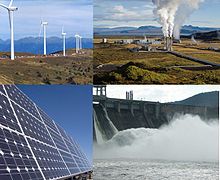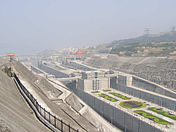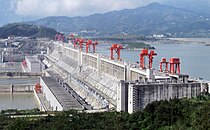Technological fix

This article is written like a personal reflection, personal essay, or argumentative essay that states a Wikipedia editor's personal feelings or presents an original argument about a topic. (August 2022) |

A technological fix, technical fix, technological shortcut or (techno-)solutionism is an attempt to use engineering or technology to solve a problem (often created by earlier technological interventions).[1]
Some references define technological fix as an "attempt to repair the harm of a technology by modification of the system", that might involve modification of the machine and/or modification of the procedures for operating and maintaining it.
Technological fixes are inevitable in modern technology. It has been observed that many technologies, although invented and developed to solve certain perceived problems, often create other problems in the process, known as externalities. In other words, there would be modification of the basic hardware, modification of techniques and procedures, or both.[2]
The technological fix is the idea that all problems can find solutions in better and new technologies. It now is used as a dismissive phrase to describe cheap, quick fixes by using inappropriate technologies; these fixes often create more problems than they solve or give people a sense that they have solved the problem.[3]
Contemporary context
[edit]In the contemporary context, technological fix is sometimes used to refer to the idea of using data and intelligent algorithms to supplement and improve human decision making in hope that this would result in ameliorating the bigger problem. One critic, Evgeny Morozov defines this as "Recasting all complex social situations either as neat problems with definite, computable solutions or as transparent and self-evident processes that can be easily optimized – if only the right algorithms are in place."[4] Morozov has defined this perspective as an ideology that is especially prevalent in Silicon Valley, and defined it as "solutionism".[1] While some criticizes this approach to the issues of today as detrimental to efforts to truly solve these problems, opponents find merits in such approach to technological improvement of our society as complements to existing activists and policy efforts.[5]
An example of the criticism is how policy makers may be tempted to think that installing smart energy monitors would help people conserve energy better, thus improving global warming, rather than focusing on the arduous process of passing laws to tax carbon, etc. Another example is the use of technological tools alone to solve complex sociopolitical crises such as pandemics, or the belief that such crises can be solved through the integration of technical fixes alone.[2]
Algorithms
[edit]The definition of algorithms according to the Oxford Languages dictionary is “a process or set of rules to be followed in calculations or other problem-solving operations, especially by a computer.” Algorithms are increasingly used as technological fixes in modern society to replace tasks or decision-making by humans, often to reduce labor costs, increase efficiency, or reduce human bias. These solutions serve as a “quick and flawless way to solve complex real world problems… but technology isn’t magic”.[6] The use of algorithms as fixes, however, are not addressing the root causes of these problems. Instead, algorithms are more often being used as “band-aid” solutions that may provide temporary relief, but do not ameliorate the issue for good. Additionally, these fixes tend to come with their own problems, some of which are even more harmful than the original problem.
One example of algorithms as a technological fix for increasing public safety is face recognition software, which has been used by the San Diego County police department [7] and the Pittsburgh police department,[8] among other government security organizations. Face recognition is an example of algorithmic technology that is viewed as potentially having many benefits for its users, such as verifying one’s identity in security systems. This system uses biometrics to quantify and map out distinguishing facial features.[9] However, face recognition as a technological fix for safety and security concerns comes with issues of privacy and discrimination. In the case of face recognition technology being used by the San Diego County police department, Black men were being falsely accused of crimes due to being mistakenly identified by the software.[7] Additionally, San Diego police used the face recognition software on African Americans up to twice as often than on other people.[7] The cases of discrimination perpetuated by the face recognition tool led to a three-year ban on its use starting in 2019. Instead of addressing systemic and historically embedded issues of inequalities among racial groups, the face recognition technology was used to perpetuate discrimination and support police in doing their jobs unfairly and inaccurately.
Another example of algorithms being used as a technological fix is tools to automate decision-making, such as in the cases of Oregon’s Child Welfare Risk Tool [10] and the Pittsburgh Allegheny County Family Screening Tool (AFST).[11] In these cases, algorithms replacing humans as decision makers have been used to fix the underlying issues of the cost of employees to make child welfare case decisions and to eliminate human biases in the decision-making process. However, researchers at Carnegie Mellon University found that the tool discriminates against Black families, who are statistically underserved and have historically lived in lower-income areas.[11] This historical data caused by systemic disparities causes the algorithm to flag a greater percentage of children of Black families as high risk than children of White families. By using data based on historical biases, the automated decisions further fuel racial disparities, and actually accomplish the opposite of the intended outcomes.
Climate change
[edit]The technological fix for climate change is an example of the use of technology to restore the environment. This can be seen through various different strategies such as: renewable energy and climate engineering.
Renewable energy
[edit]Renewable energy (or green energy) is energy from renewable natural resources that are replenished on a human timescale. The most widely used renewable energy types are solar energy, wind power, and hydropower. Bioenergy and geothermal power are also significant in some countries. Some also consider nuclear power a renewable power source, although this is controversial. Renewable energy installations can be large or small and are suited for both urban and rural areas. Renewable energy is often deployed together with further electrification. This has several benefits: electricity can move heat and vehicles efficiently and is clean at the point of consumption.[12][13] Variable renewable energy sources are those that have a fluctuating nature, such as wind power and solar power. In contrast, controllable renewable energy sources include dammed hydroelectricity, bioenergy, or geothermal power.

Climate engineering
[edit]Climate engineering (or geoengineering) is the intentional large-scale alteration of the planetary environment to counteract anthropogenic climate change.[23][24] The term has been used as an umbrella term for both carbon dioxide removal and solar radiation modification when applied at a planetary scale.[25]: 168 However, these two processes have very different characteristics, and are now often discussed separately.[25]: 168 [26] Carbon dioxide removal techniques remove carbon dioxide from the atmosphere, and are part of climate change mitigation. Solar radiation modification is the reflection of some sunlight (solar radiation) back to space to cool the earth.[27] Some publications include passive radiative cooling as a climate engineering technology. The media tends to also use climate engineering for other technologies such as glacier stabilization, ocean liming, and iron fertilization of oceans. The latter would modify carbon sequestration processes that take place in oceans.
Some types of climate engineering are highly controversial due to the large uncertainties around effectiveness, side effects and unforeseen consequences.[28] Interventions at large scale run a greater risk of unintended disruptions of natural systems, resulting in a dilemma that such disruptions might be more damaging than the climate damage that they offset.[29] However, the risks of such interventions must be seen in the context of the trajectory of climate change without them.[30][29][31]Externalities
[edit]Externalities are the unforeseen or unintended consequences of technology. It is evident that everything new and innovative can potentially have negative effects, especially if it is a new area of development. Although technologies are invented and developed to solve certain perceived problems, they often create other problems in the process.
Algorithms
[edit]Evgeny Morozov, writer and researcher on social implications of technology, has said, “A new problem-solving infrastructure is new; new types of solutions become possible that weren’t possible 15 years ago”.[6] The issue with the use of algorithms as technological fixes is that they shouldn’t be applied as a one-size-fits-all solution because each problem comes with its own context and implications. While algorithms can offer solutions, it can also amplify discriminatory harms, especially to already marginalized groups. These externalities include racial bias, gender bias, and disability discrimination.
Oftentimes, algorithms are implemented into systems without a clear understanding of whether or not it is an appropriate solution to a problem. In Understanding perception of algorithmic decisions: Fairness, trust, and emotion in response to algorithmic management, Min Kyung Lee writes, “...the problem is that industries often incorporate technology whose performance and effectiveness are not yet proven, without careful validation and reflection.” Algorithms may offer immediate relief to problems or an optimistic outlook to the current issues at hand, but they can also create more problems that require even more complex solutions. Sometimes, the use of algorithms as a technological fix leaves us asking, “Did anyone ask for this?” and wondering whether the benefits outweigh the harms. These tradeoffs should be rigorously assessed in order to determine if an algorithm is truly the most appropriate solution.
DDT
[edit]DDT was initially use by the Military in World War II to control a range of different illnesses, varying from Malaria to the bubonic plague and body lice.[32] Due to the efficiency of DDT, it was soon adopted as a farm pesticide to help maximise crop yields to consequently cope with the rising populations food demands post WWII. This pesticide proved to be extremely effective in killing bugs and animals on crops, and was often referred as the "wonder-chemical".[33] However, despite being banned for over forty years, we are still facing the externalities of this technology.[33] It was found that DDT had major health impacts on both humans and animals. It was found that DDT accumulated within the fatty cells of both humans and animals and therefore highlights that technological fixes have their negatives as well as positives.[33]

Humans
[edit]- Breast & other cancers[33]
- Male infertility[33]
- Miscarriages & low birth weight[33]
- Developmental delay[33]
- Nervous system & liver damage[33][34]
Animals
[edit]- DDT is toxic to birds when eaten.[35]
- Decreases the reproductive rate of birds by causing eggshell thinning and embryo deaths.[34]
- Highly toxic to aquatic animals. DDT affects various systems in aquatic animals including the heart and brain.[34]
- DDT moderately toxic to amphibians like frogs, toads, and salamanders. Immature amphibians are more sensitive to the effects of DDT than adults.[34]

Automobiles
[edit]Automobiles with internal combustion engines have revolutionised civilisation and technology.[36] However, whilst the technology was new and innovative, helping to connect places through the ability of transport, it was not recognised at the time that burning fossil fuels, such as coal and oil, inside the engines would release pollutants. This is an explicit example of an externality caused by a technological fix, as the problems caused from the development of the technology was not recognised at the time.
Different types of technological fixes
[edit]High-tech megaprojects
[edit]High-tech megaprojects are large scale and require huge sums of investment and revenue to be created. Examples of these high technologies are dams, nuclear power plants, and airports. They usually cause externalities on other factors such as the environment, are highly expensive, and are top-down governmental plans.

Three Gorges Dam
[edit]The Three Gorges Dam is an example of a high-tech technological fix. The creation of the multi-purpose navigation hydropower and flood control scheme was designed to fix the issues with flooding whilst providing efficient, clean renewable hydro-electric power in China. The Three Gorges Dam is the world's largest power station in terms of installed capacity (22,500 MW). The dam is the largest operating hydroelectric facility in terms of annual energy generation, generating 83.7 TWh in 2013 and 98.8 TWh in 2014, while the annual energy generation of the Itaipú Dam in Brazil and Paraguay was 98.6 TWh in 2013 and 87.8 in 2014.[37][38][39] It was estimated to have cost over £25 billion.[40] There have been many externalities from this technology, such as the extinction of the Chinese River Dolphin,[40] an increase in pollution, as the river can no longer 'flush' itself, and over 4 million locals being displaced in the area.[40]
Intermediate technology
[edit]
Is usually small-scale and cheap technologies that are usually seen in developing countries. The capital to build and create these technologies are usually low, yet labour is high.[41] Local expertise can be used to maintain these technologies making them very quick and effective to build and repair. An example of an intermediate technology can be seen by water wells, rain barrels and pumpkin tanks.
Appropriate technologies
[edit]Technology that suits the level of income, skills and needs of the people.[42] Therefore, this factor encompasses both high and low technologies.
An example of this can be seen by developing countries that implement technologies that suit their expertise, such as rain barrels and hand pumps. These technologies are low costing and can be maintained by local skills, making them affordable and efficient.[42] However, to implement rain barrels in a developed country would not be appropriate, as it would not suit the technological advancement apparent in these countries. Therefore, appropriate technological fixes take into consideration the level of development within a country before implementing them.
Concerns
[edit]Michael and Joyce Huesemann caution against the hubris of large-scale techno-fixes[43] In the book Techno-Fix: Why Technology Won't Save Us Or the Environment they show why negative unintended consequences of science and technology are inherently unavoidable and unpredictable, why counter-technologies or techno-fixes are no lasting solutions, and why modern technology in current context does not promote sustainability but instead collapse.[44]
Naomi Klein is a prominent opponent of the view that simply technological fixes will solve our problems. She explained her concerns in her book This Changes Everything: Capitalism vs. the Climate[45][46] and states that technical fixes for climate change such as geoengineering bring significant risks as "we simply don't know enough about the Earth system to be able to re-engineer it safely". According to her the proposed technique of dimming the rays of the sun with sulphate-spraying helium balloons in order to mimic the cooling effect on the atmosphere of large volcanic eruptions for instance is highly dangerous and such schemes will surely be attempted if abrupt climate change gets seriously under way.[45] Such concerns are explored in their complexity in Elizabeth Kolbert's Under a White Sky.[47]
Various experts and environmental groups have also come forward with their concerns over views and approaches that look for techno fixes as solutions and warn that those would be "misguided, unjust, profoundly arrogant and endlessly dangerous" approaches[48] as well as over the prospect of a technological 'fix' for global warming, however impractical, causing lessened political pressure for a real solution.[49]
See also
[edit]- Attitudinal fix
- Structural fix
- Differential technological development
- Law of Unintended Consequences
- Philosophy of technology
- Social engineering (political science)
- Technocentrism
References
[edit]- ^ Cook, Stephen P. The Worldview Literacy Book Parthenon Books 2009. Excerpt at http://www.projectworldview.org/wvtheme46.htm
- ^ The sacred and the limits of the technological fix AR Drengson – Zygon®, 1984, Wiley Online Library
- ^ The Technological Fix Critique of Agricultural Biotechnology, D Scott, http://wiki.umt.edu/odc/images/d/db/TechFixISU6-25.pdf Archived 2016-03-04 at the Wayback Machine
- ^ E. Morozov, To Save Everything, Click Here (2013), pg 5
- ^ Alexis C. Madrigal (13 March 2013). "Toward a Complex, Realistic, and Moral Tech Criticism". The Atlantic.
- ^ a b Samantha (2021-03-24). "Techno solutionism—very few things actually need to be an app". Digital Rights Watch. Retrieved 2022-11-30.
- ^ a b c Marx, Jesse (2022-08-24). "With State Ban Set to Expire, Local Police Could Bring Back Facial Rec". Voice of San Diego. Retrieved 2022-11-30.
- ^ Deto, Ryan. "Pittsburgh City Council introduces police facial recognition, predictive policing ban". Pittsburgh City Paper. Retrieved 2022-11-30.
- ^ "Understanding Facial Recognition Algorithms". RecFaces. 2021-03-25. Retrieved 2022-11-30.
- ^ "Oregon is dropping an artificial intelligence tool used in child welfare system". NPR. Associated Press. 2022-06-02. Retrieved 2022-11-30.
- ^ a b "How an algorithm that screens for child neglect could harden racial disparities". PBS NewsHour. 2022-04-29. Retrieved 2022-11-30.
- ^ Armaroli, Nicola; Balzani, Vincenzo (2011). "Towards an electricity-powered world". Energy and Environmental Science. 4 (9): 3193–3222. doi:10.1039/c1ee01249e. ISSN 1754-5692.
- ^ Armaroli, Nicola; Balzani, Vincenzo (2016). "Solar Electricity and Solar Fuels: Status and Perspectives in the Context of the Energy Transition". Chemistry – A European Journal. 22 (1): 32–57. doi:10.1002/chem.201503580. PMID 26584653.
- ^ "Global renewable energy trends". Deloitte Insights. Archived from the original on 29 January 2019. Retrieved 28 January 2019.
- ^ "Renewable Energy Now Accounts for a Third of Global Power Capacity". irena.org. 2 April 2019. Archived from the original on 2 April 2019. Retrieved 2 December 2020.
- ^ "2023 Levelized Cost Of Energy+". www.lazard.com. Retrieved 2024-06-10.
- ^ IEA (2020). Renewables 2020 Analysis and forecast to 2025 (Report). p. 12. Archived from the original on 26 April 2021. Retrieved 27 April 2021.
- ^ "Renewables 2022". Global Status Report (renewable energies): 44. 14 June 2019. Retrieved 5 September 2022.
- ^ "Share of electricity production from renewables". Our World in Data. 2023. Retrieved 15 August 2023.
- ^ "Renewables - Energy System". IEA. Retrieved 2024-05-23.
- ^ Ritchie, Hannah; Roser, Max; Rosado, Pablo (January 2024). "Renewable Energy". Our World in Data.
- ^ Sensiba, Jennifer (2021-10-28). "Some Good News: 10 Countries Generate Almost 100% Renewable Electricity". CleanTechnica. Archived from the original on 17 November 2021. Retrieved 2021-11-22.
- ^ Shepherd, John (2009). "Geoengineering the climate: science, governance and uncertainty". royalsociety.org. Royal Society of London. p. 1. ISBN 978-0-85403-773-5. Retrieved 2024-10-28.
- ^ Union of Concerned Scientists (6 November 2017). "What is Climate Engineering?". www.ucsusa.org. Retrieved 2024-10-28.
{{cite web}}: CS1 maint: date and year (link) - ^ a b IPCC (2022) Chapter 1: Introduction and Framing in Climate Change 2022: Mitigation of Climate Change. Contribution of Working Group III to the Sixth Assessment Report of the Intergovernmental Panel on Climate Change, Cambridge University Press, Cambridge, United Kingdom and New York, NY, USA
- ^ IPCC, 2021: Annex VII: Glossary [Matthews, J.B.R., V. Möller, R. van Diemen, J.S. Fuglestvedt, V. Masson-Delmotte, C. Méndez, S. Semenov, A. Reisinger (eds.)]. In Climate Change 2021: The Physical Science Basis. Contribution of Working Group I to the Sixth Assessment Report of the Intergovernmental Panel on Climate Change [Masson-Delmotte, V., P. Zhai, A. Pirani, S.L. Connors, C. Péan, S. Berger, N. Caud, Y. Chen, L. Goldfarb, M.I. Gomis, M. Huang, K. Leitzell, E. Lonnoy, J.B.R. Matthews, T.K. Maycock, T. Waterfield, O. Yelekçi, R. Yu, and B. Zhou (eds.)]. Cambridge University Press, Cambridge, United Kingdom and New York, NY, USA, pp. 2215–2256, doi:10.1017/9781009157896.022.
- ^ National Academies of Sciences, Engineering (2021-03-25). Reflecting Sunlight: Recommendations for Solar Geoengineering Research and Research Governance. doi:10.17226/25762. ISBN 978-0-309-67605-2. S2CID 234327299. Archived from the original on 2021-04-17. Retrieved 2021-04-17.
- ^ Gernot Wagner (2021). Geoengineering: the Gamble.
- ^ a b Matthias Honegger; Axel Michaelowa; Sonja Butzengeiger-Geyer (2012). Climate Engineering – Avoiding Pandora's Box through Research and Governance (PDF). FNI Climate Policy Perspectives. Fridtjof Nansen Institute (FNI), Perspectives. Archived from the original (PDF) on 2015-09-06. Retrieved 2018-10-09.
- ^ Trakimavicius, Lukas. "Playing God with climate: the EU's geoengineering conundrum". EUISS.
- ^ Zahra Hirji (October 6, 2016). "Removing CO2 From the Air Only Hope for Fixing Climate Change, New Study Says; Without 'negative emissions' to help return atmospheric CO2 to 350 ppm, future generations could face costs that 'may become too heavy to bear,' paper says". insideclimatenews.org. InsideClimate News. Archived from the original on November 17, 2019. Retrieved October 7, 2016.
- ^ "NPIC – National Pesticide Information Centre" (PDF).
- ^ a b c d e f g h "The DDT Story | Pesticide Action Network". www.panna.org. 15 July 2015. Retrieved 2015-10-29.
- ^ a b c d "World Health Organization. DDT and its derivatives. Environmental aspects. Environmental Health Criteria. Geneva, Switzerland, 1989; Vol. 83". DDT. 2015-10-29.
- ^ Toxicology Profile for (Update); U. S. Department of Human Health & Human Services, Agency for Toxic Substances and Disease Registry, 1994.
- ^ "internal-combustion engine: Introduction". www.infoplease.com. Retrieved 2015-11-03.
- ^ "Generation". Itaipu Binacional. Retrieved 2 January 2015.
- ^ "Three Gorges breaks world record for hydropower generation". Xinhua. 1 January 2014. Archived from the original on January 2, 2015. Retrieved 2 January 2015.
- ^ "Drought curbs Itaipu hydro output". Business News Americas. 5 January 2015. Retrieved 5 January 2015.
- ^ a b c "GoConqr - Types of technological fix". GoConqr. Retrieved 2015-11-02.
- ^ Welfens, Paul J. J.; Ryan, Cillian (2011). Financial Market Integration and Growth: Structural Change and Economic Dynamics in the European Union. Springer Science & Business Media. ISBN 9783642162749.
- ^ a b "Appropriate Technology text". lsa.colorado.edu. Retrieved 2015-11-03.
- ^ "Moonshots for the Earth: are there technological fixes for climate change?". New Statesman. 29 November 2015. Retrieved 11 February 2017.
- ^ "Techno-Fix". New Society Publishers. Retrieved 11 February 2017.
- ^ a b Gray, John (22 September 2014). "This Changes Everything: Capitalism vs the Climate review – Naomi Klein's powerful and urgent polemic". The Guardian. Retrieved 11 February 2017.
- ^ Scipes, Kim. "A Review of Naomi Klein, This Changes Everything" (PDF). Retrieved 11 February 2017.
- ^ Frank, Adam (8 February 2021). "'Under A White Sky' Examines What It Might Take For Humans To Continue To Exist". NPR.org. Retrieved 2021-03-08.
- ^ "Geoengineering Has No Place Among Serious Climate Solutions, Declare Experts". BillMoyers.com. 16 February 2015. Retrieved 11 February 2017.
- ^ Carpenter, Zoë (10 February 2015). "Scientists: We Cannot Geoengineer Our Way Out of the Climate Crisis". The Nation. Retrieved 11 February 2017.



